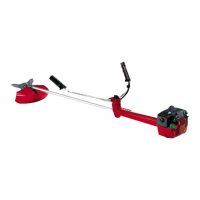12 – English
SAFETY INSTRUCTIONS
• To fell to the left, the bottom of the tree should be pushed
to the right. Tilt the blade and bring it diagonally down to
the right, exerting firm pressure. At the same time push
the stem using the blade guard. Cut with the area of the
blade between 3 o’clock and 5 o’clock. Apply full throttle
before advancing the blade.
• To fell to the right, the bottom of the tree should be pushed
to the left. Tilt the blade and bring it diagonally up to the
right. Cut with the area of the blade between 3 o’clock and
5 o’clock so that the direction of rotation of the blade
pushes the bottom of the tree to the left.
• To fell a tree forwards, the bottom of the tree should be
pulled backwards. Pull the blade backwards with a quick,
firm movement.
• Large stems must be cut from two sides. First determine
which direction the stem will fall. Make the first cut on the
felling side. Then finish cutting the stem from the other
side. Adjust the cutting pressure to match the size of the
stem and the hardness of the wood. Small stems require
more pressure, while large stems require less pressure.
• If the stems are tightly packed, adapt your walking pace to
suit.
• If the blade jams in a stem, never jerk the machine free. If
you do this the blade, bevel gear, shaft or handlebar may
be damaged. Release the handles, grip the shaft with
both hands and gently pull the machine free.
Brush cutting with a saw blade
• Thin stems and brush are mown down. Work with a
sawing movement, swinging sideways.
• Try to cut several stems in a single sawing movement.
• With groups of hardwood stems, first clear around the
group. Start by cutting the stems high up around the
outside of the group to avoid jamming. Then cut the stems
to the required height. Now try to reach in with the blade
and cut from the centre of the group. If it is still difficult to
gain access, cut the stems high up and let them fall. This
will reduce the risk of jamming.
Grass clearing using a grass blade
• A grass blade is used for all types of tall or coarse grass.
• The grass is cut down with a sideways, swinging
movement, where the movement from right-to-left is the
clearing stroke and the movement from left-to-right is the
return stroke. Let the left-hand side of the blade (between
8 and 12 o’clock) do the cutting.
• If the blade is angled to the left when clearing grass, the
grass will collect in a line, which makes it easier to collect,
e.g. by raking.
• Try to work rhythmically. Stand firmly with your feet apart.
Move forward after the return stroke and stand firmly
again.
• Let the support cup rest lightly against the ground. It is
used to protect the blade from hitting the ground.
• Reduce the risk of material wrapping around the blade by
following these instructions:
1 Always work at full throttle.
2 Avoid the previously cut material during the return
stroke.
• Stop the engine, unclip the harness and place the
machine on the ground before you start to collect the cut
material.
!
WARNING! Neither the operator of the
machine nor anyone else may attempt to
remove the cut material while the engine is
running or the blade is rotating, as this can
result in serious injury.
Stop the engine and blade before you
remove material that has wound around the
blade shaft as otherwise there is a risk of
injury. The bevel gear can get hot during use
and may remain so for a while afterwards.
You could get burnt if you touch it.

